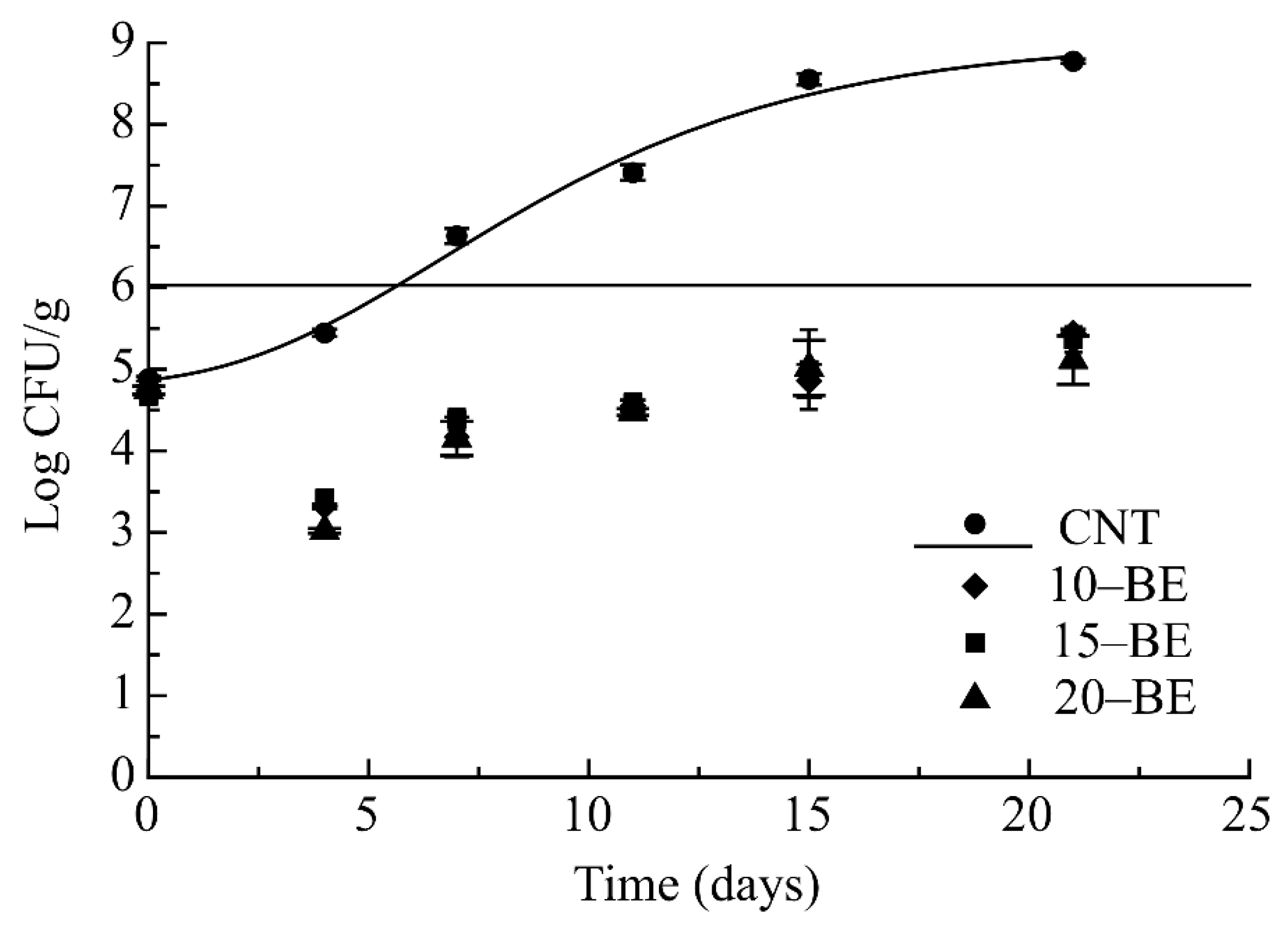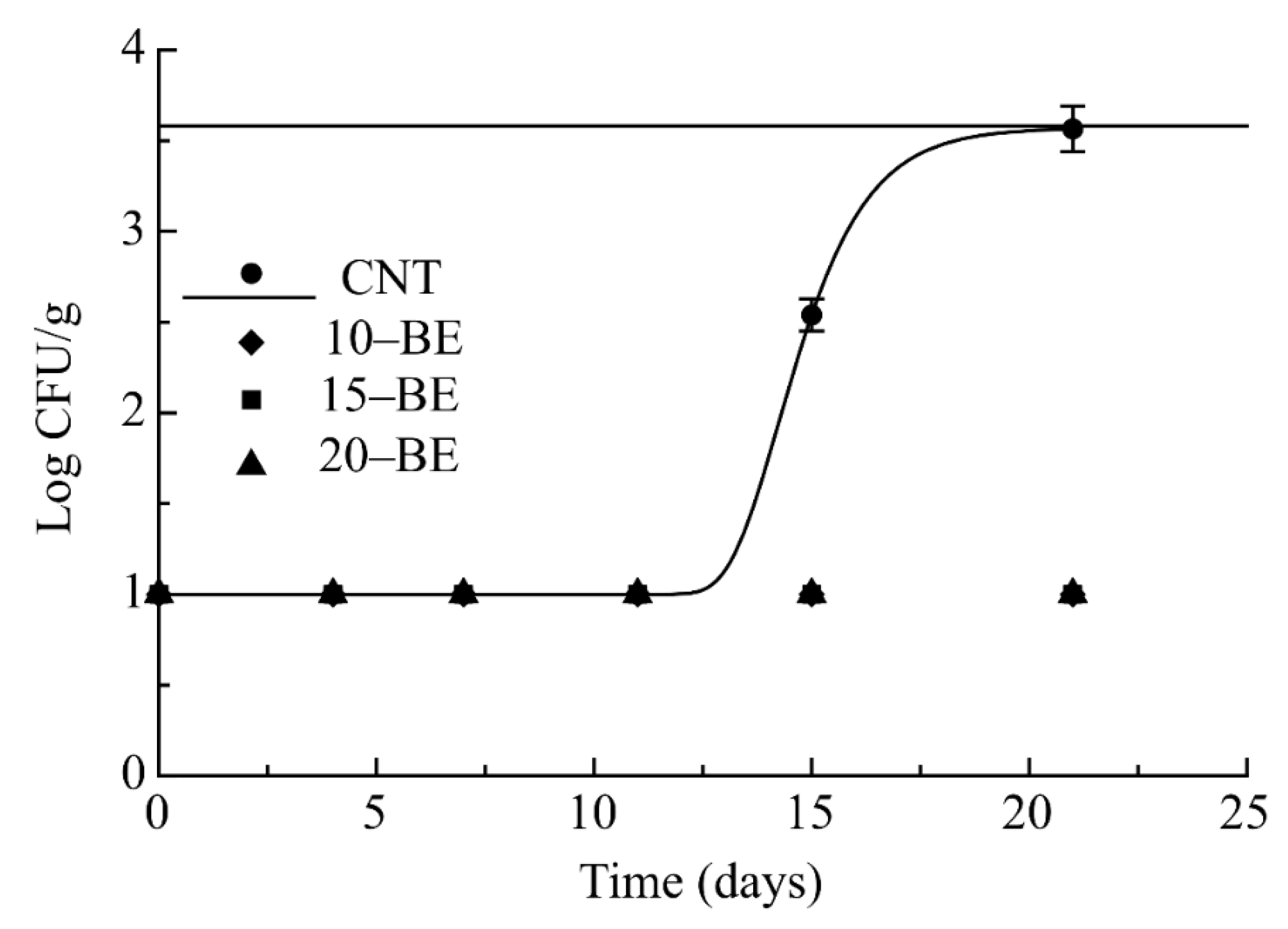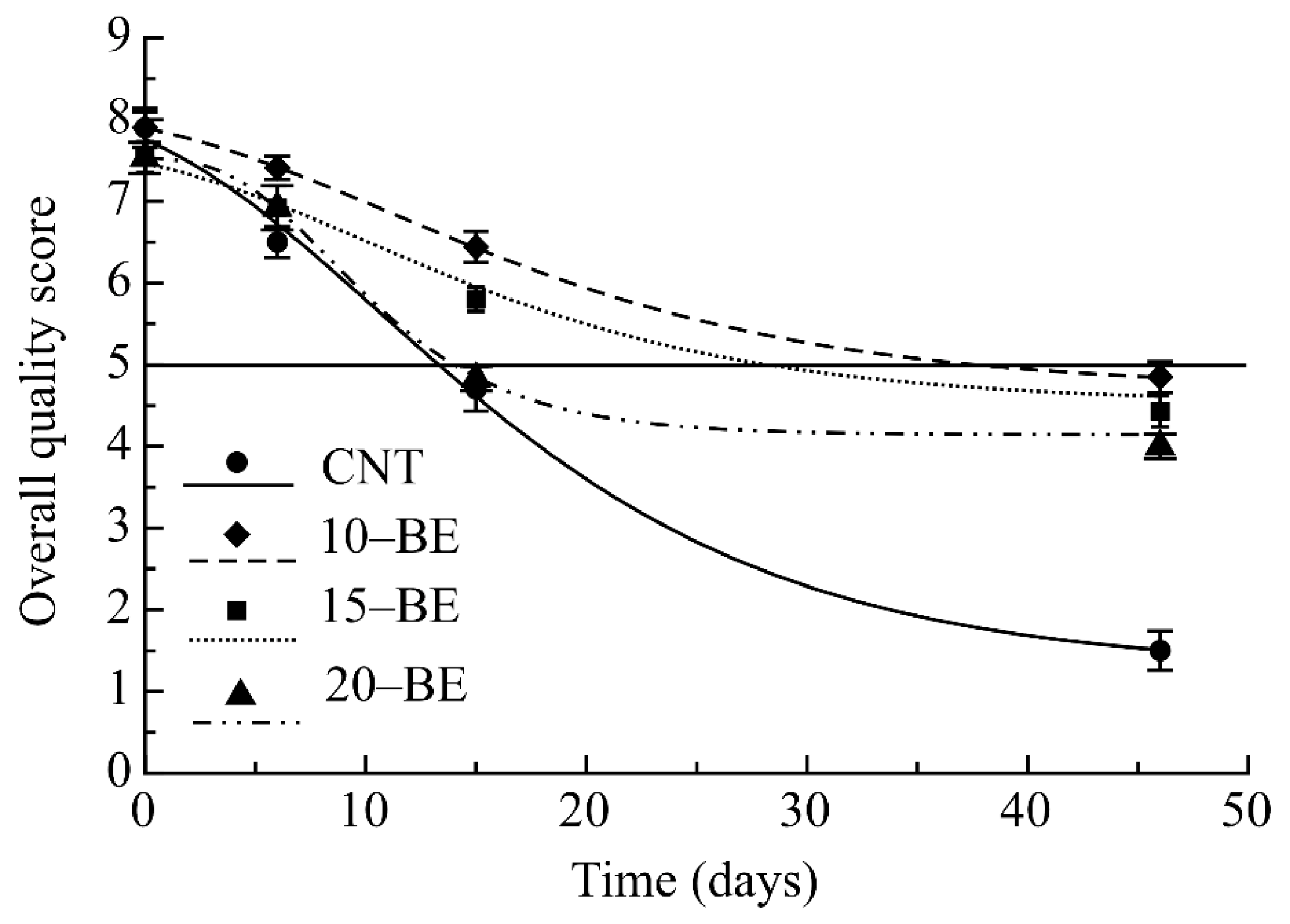Extract from Broccoli Byproducts to Increase Fresh Filled Pasta Shelf Life
Abstract
1. Introduction
2. Material and Methods
2.1. Raw Materials
2.2. SFE
2.3. Fresh Filled Pasta Production
2.4. Microbiological Analyses
2.5. Sensory Analysis
2.6. Chemical Analyses
2.6.1. Extraction of Polyphenols from Cooked Pasta Samples
2.6.2. In Vitro Digestion of Cooked Pasta Samples
2.6.3. Total Phenolic Content
2.7. Statistical Analysis
3. Results and Discussion
3.1. Total Phenolic Content
3.2. Quality of Fresh Filled Pasta
4. Conclusions
Author Contributions
Funding
Conflicts of Interest
References
- Capozzi, V.; Russo, P.; Fragasso, M.; De Vita, P.; Fiocco, D.; Spano, G. Biotechnology and Pasta-Making: Lactic Acid Bacteria as a New Driver of Innovation. Front. Microbiol. 2012, 3, 94. [Google Scholar] [CrossRef] [PubMed]
- ICMSF Members. Microbial Ecology of Food Commodities, 2nd ed.; Roberts, T.A., Cordier, J.L., Gram, L., Tompkin, R.B., Pitt, J.I., Gorris, L.G.M., Swanson, K.M.J., Eds.; Kluwer Academic/Plenum Publishers: New York, NY, USA, 2005. [Google Scholar]
- Angiolillo, L.; Conte, A.; Del Nobile, M.A. Biotechnological approach to preserve fresh pasta quality. J. Food Prot. 2017, 80, 2006–2013. [Google Scholar] [CrossRef] [PubMed]
- Costa, C.; Lucera, A.; Mastromatteo, M.; Conte, A.; Del Nobile, M.A. Shelf life extension of durum semolina-based fresh pasta. Int. J. Food Sci. Technol. 2010, 45, 1545–1551. [Google Scholar] [CrossRef]
- Presidenza della Repubblica. Regolamento per la revisione della normativa sulla produzione e commercializzazione di sfarinati e paste alimentari, 2001 a norma dell’articolo 50 della legge 22 febbraio 1994. Gazz. Uff. della Repubb. Ital. 2001, 187, Art.9. [Google Scholar]
- Zardetto, S.; Di Fresco, S.; Dalla Rosa, M. Effetto di trattamenti termici su alcune caratteristiche chimico-fisiche della pasta fresca farcita. Tec. Molit. 2002, 53, 113–130. [Google Scholar]
- Lee, M.H.; No, H.K. Effect of chitosan on shelf life and quality of wet noodle. J. Chitin Chitosan 2010, 7, 14–17. [Google Scholar]
- Sanguinetti, A.M.; Del Caro, A.; Scanu, A.; Fadda, C.; Milella, G.; Catzeddu, P.; Piga, A. Extending the shelf life of gluten-free fresh filled pasta by modified atmosphere packaging. LWT-Food Sci. Technol. 2016, 71, 96–101. [Google Scholar] [CrossRef]
- Sanguinetti, A.M.; Del Caro, A.; Mangia, N.P.; Secchi, N.; Catzeddu, P.; Piga, A. Quality Changes of Fresh Filled Pasta during Storage: Influence of Modified Atmosphere Packaging on Microbial Growth and Sensory Properties. Food Sci. Technol. 2011, 17, 23–27. [Google Scholar] [CrossRef]
- Zardetto, S. Effect of modified atmosphere packaging at abuse temperature on the growth of Penicillium Aurantiogriseum isolated from fresh filled pasta. Food Microbiol. 2005, 22, 367–371. [Google Scholar] [CrossRef]
- Castelvetri, F. Il confezionamento in atmosfera modificata dei prodotti di pasta fresca. Tec. Molit. 1991, 30, 875–879. [Google Scholar]
- Del Nobile, M.A.; Di Benedetto, N.; Suriano, N.; Conte, A.; Lamacchia, C.; Corbo, M.R.; Sinigaglia, M. Use of natural compounds to improve the microbial stability of amaranth-based homemade fresh pasta. Food Microbiol. 2009, 26, 151–156. [Google Scholar] [CrossRef] [PubMed]
- Baydar, N.G.; Ozkan, G.; Sagdic, O. Total phenolic content and antibacterial activities of grape extracts. Food Control 2004, 15, 335–339. [Google Scholar] [CrossRef]
- Martin, J.G.P.; Porto, E.; Correa, C.B.; Alencar, S.M.; Gloria, E.M.; Cabral, I.S.R.; Arquino, L.M. Antimicrobial potential and chemical composition of agro-industrial wastes. J. Nat. Prod. 2012, 5, 27–36. [Google Scholar]
- Wijngaard, H.H.; Rößle, C.; Brunton, N. A survey of Irish fruit and vegetable waste and by product as a source of polyphenolic antioxidants. Food Chem. 2009, 116, 202–207. [Google Scholar] [CrossRef]
- Pormortazavi, S.M.; Hajimirsadegui, S.H. Supercritical fluid extraction in plant essential and volatile oil analysis. J. Chromatogr. A 2007, 1163, 2–24. [Google Scholar] [CrossRef]
- Brunner, G. Supercritical fluids: Technology and application to food processing. J. Food Eng. 2005, 67, 21–33. [Google Scholar] [CrossRef]
- Arnaiz, E.; Bernal, J.; Martin, M.T.; Diego, J.C.; Bernal, J.L.; Toribio, L. Optimization of the supercritical fluid extraction of antioxidants from broccoli leaves. Food Anal. Methods. 2016, 9, 2174–2181. [Google Scholar] [CrossRef]
- Conte, A.; Gammariello, D.; Di Giulio, S.; Attanasio, M.; Del Nobile, M.A. Active coating and modified-atmosphere packaging to extend the shelf life of Fior di Latte cheese. J. Dairy Sci. 2009, 92, 887–894. [Google Scholar] [CrossRef]
- Del Nobile, M.A.; Corbo, M.R.; Speranza, B.; Sinigaglia, M.; Conte, A.; Caroprese, M. Combined effect of MAP and active compounds on fresh blue fish burger. Int. J. Food Microbiol. 2009, 135, 281–287. [Google Scholar] [CrossRef]
- Del Nobile, M.A.; Conte, A.; Cannarsi, M.; Sinigaglia, M. Strategies for prolonging the shelf life of minced beef patties. J. Food Saf. 2009, 29, 14–25. [Google Scholar] [CrossRef]
- Rashidinejad, A.; Birch, E.J.; Sun-Waterhouse, D.; Everett, D.W. Effects of catechin on the phenolic content and antioxidant properties of low fat cheese. Int. J. Food Sci. Technol. 2013, 48, 2448–2455. [Google Scholar] [CrossRef]
- da Silva, F.C.; da Fonseca, C.R.; de Alencar, S.M.; Thomazini, M.; Baliero, J.C.; Pittia, P.; Favaro-Trindade, C.S. Assessment of production efficiency, physicochemical properties and storage stability of spry-dried propolis, a natural food additive, using gum arabic and osa starch-based carrier systems. Food Bioprod. Process. 2013, 91, 28–36. [Google Scholar] [CrossRef]
- Mehanna, N.S.; Hassan, Z.M.R.; El-Din, H.M.F.; Ali, A.A.E.; Amarowicz, R.; EL-Messery, T.M. Effect of interaction phenolic compounds with milk proteins on cell line. Food Nutr. Sci. 2014, 5, 2130–2146. [Google Scholar] [CrossRef]
- Gallo, M.; Vinci, G.; Graziani, G.; De Simone, C.; Ferranti, P. The interaction of cocoa polyphenols with milk proteins studied by proteomic techniques. Food Res. Int. 2013, 54, 406–415. [Google Scholar] [CrossRef]
- Prajapati, M.R.; Patel, V.; Parekh, T.; Subhash, R. Effect of in bio-processing on antioxidant activity of selected cereals. Asian J. Plant Sci. Res. 2013, 3, 66–72. [Google Scholar]
- Ti, H.; Zhang, R.; Li, Q.; Wei, Z.; Zhang, M. Effects of cooking and in vitro digestion of rice on phenolic profiles and antioxidant activity. Food Res. Int. 2015, 76, 813–820. [Google Scholar] [CrossRef]
- Gumienna, M.; Lasik, M.; Czarnecki, Z. Influence of plant extracts addition on the antioxidative properties of products obtained from green lentil seeds during in vitro digestion process. Pol. J. Food Nut. Sci. 2009, 59, 295–298. [Google Scholar]
- Cartea, M.E.; Francisco, M.; Soengas, P.; Velasco, P. Phenolic compounds in Brassica vegetables. Molecules 2010, 16, 251–280. [Google Scholar] [CrossRef]
- Jaiswal, A.K.; Nissreen, A.G.; Gupta, S. A comparative study on the polyphenolic content, antibacterial activity and antioxidant capacity of different solvent extracts of Brassica oleracea vegetables. Int. J. Food Sci. Technol. 2012, 47, 223–231. [Google Scholar] [CrossRef]
- Correa, C.B.; Martin, J.G.P.; Alencar, S.M.; Porto, E. Antilisterial activity of broccoli stems (Brassica Oleracea) by flow cytometry. Int. Food Res. J. 2014, 21, 395. [Google Scholar]
- Sibi, G.; Abhilasha, S.; Dhananjava, K.; Rovikumar, K.R.; Mallesha, H. In vitro antimicrobial activities of Broccoli against food borne bacteria. J. Appl. Pharm. Sci. 2013, 3, 100–103. [Google Scholar]
- Seberian, H.; Hamidi, E.Z.; Abbassi, S. Effect of conventional and ohmic pasteurization on some bioactive components of aloe Vera gel juice. Iran. J. Chem. Chem. Eng. 2015, 34, 99–108. [Google Scholar]
- Ligor, M.; Trziszka, T.; Buszewski, B. Study of antioxidant activity of biologically active compounds isolated from green vegetables by coupled analytical techniques. Food Anal. Methods. 2013, 6, 630–636. [Google Scholar] [CrossRef]
- Pandey, K.B.; Rizvi, S.I. Plant polyphenols as dietary antioxidants in human health and disease. Oxid. Med. Cell. Longev. 2009, 2, 270–278. [Google Scholar] [CrossRef]
- Bhattacherjee, A.K.; Tandon, D.K.; Dikshit, A.; Kumar, S. Effect of pasteurization temperature on quality of aonla juice during storage. J. Food Sci. Technol. 2011, 48, 269–273. [Google Scholar] [CrossRef]



| TPC (mg GAEs/g Ravioli) | ||
|---|---|---|
| Undigested | Digested | |
| CNT | 0.63 ± 0.03 a | 0.81 ± 0.01 a |
| 10-BE | 1.84 ± 0.08 b | 2.13 ± 0.10 b |
| 15-BE | 1.84 ± 0.18 b | 2.23 ± 0.10 b |
| 20-BE | 1.86 ± 0.12 b | 2.61 ± 0.16 c |
| Sample | Microbial Quality (Day) | Sensory Quality Uncooked Pasta (Day) | Sensory Quality Cooked Pasta (Day) | Shelf Life (Day) | ||
|---|---|---|---|---|---|---|
| MAL Mesoph | MAL Staph | VMT | SAL | SAL | ||
| CNT | 5.57 ± 0.33 a | 22.4 ± 0.10 | 13 | 12.95 ± 0.26 a | 12.45 ± 0.10 a | 5.57 ± 0.33 a |
| 10-BE | 24.21 ± 0.11 b | ˃25 | ˃25 | 40.91 ± 0.23 d | 43.25 ± 0.20 d | 24.21 ± 0.11 c |
| 15-BE | 23.72 ± 0.12 b | ˃25 | ˃25 | 27.76 ± 0.15 c | 39.16 ± 0.15 c | 23.72 ± 0.12 c |
| 20-BE | 24.33 ± 0.10 b | ˃25 | ˃25 | 14.54 ± 0.21 b | 19.10 ± 0.17 b | 14.54 ± 0.21 b |
© 2019 by the authors. Licensee MDPI, Basel, Switzerland. This article is an open access article distributed under the terms and conditions of the Creative Commons Attribution (CC BY) license (http://creativecommons.org/licenses/by/4.0/).
Share and Cite
Angiolillo, L.; Spinelli, S.; Conte, A.; Del Nobile, M.A. Extract from Broccoli Byproducts to Increase Fresh Filled Pasta Shelf Life. Foods 2019, 8, 621. https://doi.org/10.3390/foods8120621
Angiolillo L, Spinelli S, Conte A, Del Nobile MA. Extract from Broccoli Byproducts to Increase Fresh Filled Pasta Shelf Life. Foods. 2019; 8(12):621. https://doi.org/10.3390/foods8120621
Chicago/Turabian StyleAngiolillo, Luisa, Sara Spinelli, Amalia Conte, and Matteo Alessandro Del Nobile. 2019. "Extract from Broccoli Byproducts to Increase Fresh Filled Pasta Shelf Life" Foods 8, no. 12: 621. https://doi.org/10.3390/foods8120621
APA StyleAngiolillo, L., Spinelli, S., Conte, A., & Del Nobile, M. A. (2019). Extract from Broccoli Byproducts to Increase Fresh Filled Pasta Shelf Life. Foods, 8(12), 621. https://doi.org/10.3390/foods8120621







